Numerical Optimization of the Blank Dimensions in Tube Hydroforming Using Line-Search and Bisection Methods
Abstract
1. Introduction
2. Materials and Methods
2.1. Part Geometries
- Long bulge height (Htarget) compared to the tube diameter (Htarget/Df equal to 1.9/1 and 1.5/1 respectively),
- Minimum wall thickness (wmin),
- Outer diameter corresponding to commercial blank tubes (available and suitable for the Company),
- AISI 316L material to comply with drinking water standards.
2.2. FEM Model
3. Process Optimization
- Step 1—process parameter curves. In this step, a FEM model was used to preliminary investigate the process and to identify which configurations enhance the feasibility of the part. At the end of the step, proper process parameters (pressure, punch strokes and counter-force curves) were identified and kept constant in the following steps so to focus the further analysis on less variables. Moreover, the limits where the model is stable (stability domain) were identified in terms of maximum and minimum tube dimensions (length and thickness).
- Step 2—numerical optimization. After the reduction of the number of free variables through the identification of the process curves, this step adopted a systematic approach based on numerical optimization techniques with the aim of identifying the dimensions of the tube (length and thickness, i.e., minimum amount of material) that guarantee the part requirements in terms of final height and thickness (Htarget and wmin). Their numerical optimization was constrained by the stability domain of the FEM.
- Step 3—experimental tests and final adjustments. The previous steps identified a process configuration, which is close to the optimum. Therefore, it was used as a starting point for an experimental campaign that tuned the industrial process. At the end of this step, the optimized process parameters for the production of the two parts were identified.
3.1. FEM Model
3.2. Tube Dimensions
3.2.1. Numerical Optimization Method—Description
- = (L, w),
- Constrain: L∈(Lmin; Lmax) ∧ w∈(wmin; wmax).
- Line–search method,
- Step direction: along ,
- Step length (ΔLi, Δwi): 1/10 of the domain amplitude.
- Bisection method,
- Step direction: along ,
- Step length (ΔLi, Δwi): ΔLi (or Δwi) halved at each inversion of sign for (or ),
- Convergence criterion: |ΔLi| ≤ 1 mm ∧ |Δwi| ≤ 0.02 mm.
3.2.2. Numerical Optimization Method—Implementation
3.3. Experimental Tests and Final Adjustments
4. Discussion
- H(wmin) = Htarget. It represents the most restrictive geometric requirement to focus on for the design of the process. Moreover, its achievement was very expensive in terms of blank material. In fact, a lot of material accumulated on the feeding sides during the process and only few materials reached the bulged branch of the part increasing H(wmin).
- Blank Tube Thickness (w). The numerical optimization showed that the optimum thickness of the initial blank tube was close to the minimum thickness allowed on the final part w = wmin.
- Blank tube Length (L). The length of the initial blank tube had a direct influence on H(wmin). However, the material accumulated along the feeding sides rather than reaching the expansion zone. Therefore, increasing L to enhance H(wmin) was not very efficient considering the need of raw material.
- Initial deformation. The deformation that occurred at the beginning of the process was crucial for the minimum thickness of the part. In particular, the minimum thickness in the free expansion area was mainly determined by the deformation of the tube during the initial phases. Therefore, it was important to improve these phases (see the following discussion on precrash and pressure). This result is opposite to what happens in the filling of closed die corners [23] where the minimum thickness is reached at the end of the forming process.
- Precrash. The use of a bulged counter-punch to preform the tube before expansion allowed us to reduce the thinning of the part so increasing its feasibility in accordance to [22].
- Pressure. A low pressure should be adopted in the early phase of the process so expanding the tube and reducing its thinning. After that, the pressure was less influent on thinning and it could be raised to contrast wrinkles. Moreover, as discussed in [24] the pressure is not expected to significantly enhance the height of the bulged branch, which is, as discussed, the most restrictive geometric requirement of the part.
- Other parameters. Process parameters as counter-punch force and punch velocity did not influence the feasibility of the part.
5. Conclusions
Author Contributions
Funding
Acknowledgments
Conflicts of Interest
References
- Alzahrani, B.; Ngaile, G. Preliminary investigation of the process capabilities of hydroforging. Materials 2016, 9, 40. [Google Scholar] [CrossRef] [PubMed]
- Lang, L.H.; Wang, Z.R.; Kang, D.C.; Yuan, S.J.; Zhang, S.H.; Danckert, J.; Nielsen, K.B. Hydroforming highlights: Sheet hydroforming and tube hydroforming. J. Mater. Process. Technol. 2004, 151, 165–177. [Google Scholar] [CrossRef]
- Hashemia, R.; Abrinia, K.; Assempour, A. The strain gradient approach to predict necking in tube hydroforming. J. Manuf. Process. 2013, 15, 51–55. [Google Scholar] [CrossRef]
- Fiorentino, A.; Ceretti, E.; Giardini, C. Tube hydroforming compression test for friction estimation—Numerical inverse method, application and analysis. Int. J. Adv. Manuf. Technol. 2013, 64, 695–705. [Google Scholar] [CrossRef]
- Fiorentino, A.; Ceretti, E.; Braga, D.; Marzi, R. Friction in asymmetric feeding tube hydroforming. Int. J. Mat. Form. 2010, 3, 275–278. [Google Scholar] [CrossRef]
- Fiorentino, A.; Marzi, R.; Ceretti, E.; Giardini, C. Y-joint THF simulation using asymmetric feeding lengths. In Proceedings of the ASME/MSEC 2010—International Conference on Manufacturing Science and Engineering, Erie, PA, USA, 12–15 October 2010; pp. 641–646. [Google Scholar]
- Rasquinha, I.; Daniel, R.K. Light weighting through tube hydroforming. SAE Technical Papers Volume 4. In Proceedings of the SAE International Conference on Automotive Materials and Manufacturing, Pune, India, 28–30 April 2014; Volume 4, p. 107160. [Google Scholar]
- Lanzerath, H.; Tuerk, M. Lightweight potential of ultra high strength steel tubular body structures. SAE Int. J. Mat. Manuf. 2015, 8, 813–822. [Google Scholar] [CrossRef]
- Ruan, S.; Lang, L. Multi-step hydroforming process technology of aero-engine guide vane Liner. IOP Conf. Ser. Mater. Sci. Eng. 2018, 397, 012146. [Google Scholar] [CrossRef]
- Cai, Y.; Wang, X.; Yuan, S. Surface roughening behavior of 6063 aluminum alloy during bulging by spun tubes. Materials 2017, 10, 299. [Google Scholar] [CrossRef] [PubMed]
- Oh, S.H.; Jeon, B.H.; Kim, H.Y.; Yang, J.B. Applications of hydroforming processes to automobile parts. J. Mater. Process. Technol. 2006, 174, 42–45. [Google Scholar] [CrossRef]
- Ray, P.; Mac Donald, B.J. Experimental study and finite element analysis of simple X- and T-branch tube hydroforming processes. Int. J. Mech. Sci. 2005, 47, 1498–1518. [Google Scholar] [CrossRef]
- Alaswad, A.; Benyounis, K.Y.; Olabi, A.G. Finite element comparison of single and bi-layered tube hydroforming processes. Simul. Model. Pract. Theory 2011, 19, 1584–1593. [Google Scholar] [CrossRef]
- Quarteroni, A.; Saleri, F.; Gervasio, P. Chapter 7—Numerical optimization. In Calcolo Scientifico, 6th ed.; Quarteroni, A., Ed.; Springer: Berlin/Heidelberg, Germany, 2017; ISBN 978-88-470-3952-0. [Google Scholar] [CrossRef]
- Quarteroni, A.; Saleri, F.; Gervasio, P. Chapter 2—Not linear equations. In Calcolo Scientifico, 6th ed.; Quarteroni, A., Ed.; Springer: Berlin/Heidelberg, Germany, 2017; ISBN 978-88-470-3952-0. [Google Scholar] [CrossRef]
- Hwang, Y.M.; Lin, Y.; Altan, T. Evaluation of tubular materials by a hydraulic bulge test. Int. J. Mach. Tools Manuf. 2007, 47, 343–351. [Google Scholar] [CrossRef]
- Bortot, P.; Ceretti, E.; Giardini, C. The determination of flow stress of tubular material for hydroforming applications. J. Mater. Process. Technol. 2008, 203, 381–388. [Google Scholar] [CrossRef]
- Attanasio, A.; Fiorentino, A.; Ceretti, E.; Giardini, C. Experimental device to study surface contacts in forming processes. In AIP Conference Proceedings, Proceedings of the 10th ESAFORM Conference on Material Forming, Zaragoza, Spain, 18–20 April 2007; Cueto, E.: Zaragoza, Spain, 2007; Volume 907, pp. 275–278. [Google Scholar]
- Fiorentino, A.; Ceretti, E.; Attanasio, A.; Braga, D.; Giardini, C. Experimental study of lubrication influence in the production of hydroformed T-Joint tubes. Key Eng. Mater. 2009, 410–411, 15–24. [Google Scholar] [CrossRef]
- PamStamp 2018 Reference Manual; S. Chand: New Delhi, India, 2008.
- Hu, Z.J.; Zhang, F.F.; Chen, J.; Han, C. Uniform thickness distribution oriented preforming design of tube hydroforming with rectangular section. J. Plast. Eng. 2015, 22, 92–97. [Google Scholar]
- Trott, A.; Nikhare, C.P. Effect of preform during low pressure tube hydroforming. In Proceedings of the ASME International Mechanical Engineering Congress and Exposition, Pittsburgh, PA, USA, 9–15 November 2018; Volume 2, p. 144113. [Google Scholar]
- Liu, G.; Yuan, S.; Teng, B. Analysis of thinning at the transition corner in tube hydroforming. J. Mater. Process. Technol. 2006, 177, 688–691. [Google Scholar] [CrossRef]
- Feng, Y.; Zhang, H.; Luo, Z.; Wu, Q. Loading path optimization of T tube in hydroforming process using response surface method. Int. J. Adv. Manuf. Technol. 2019, 101, 1979–1995. [Google Scholar]
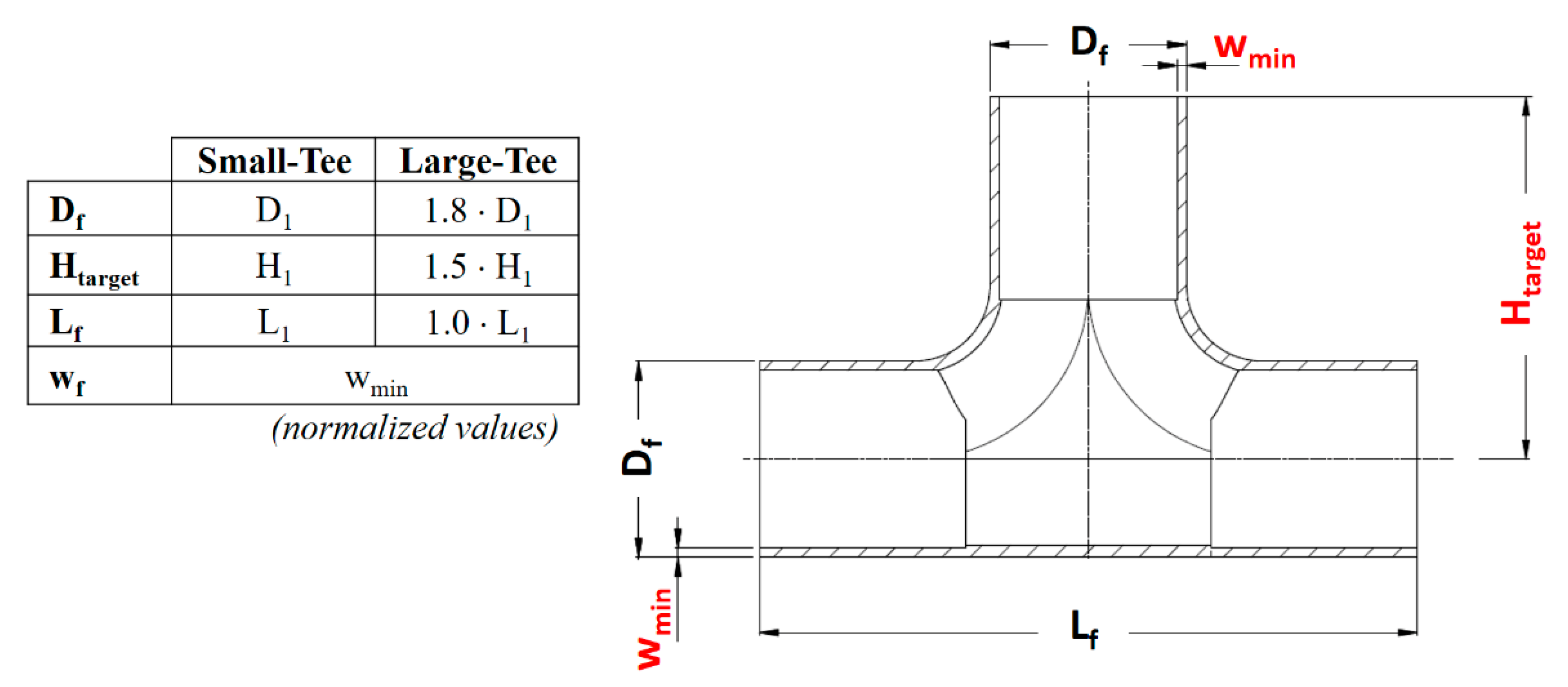
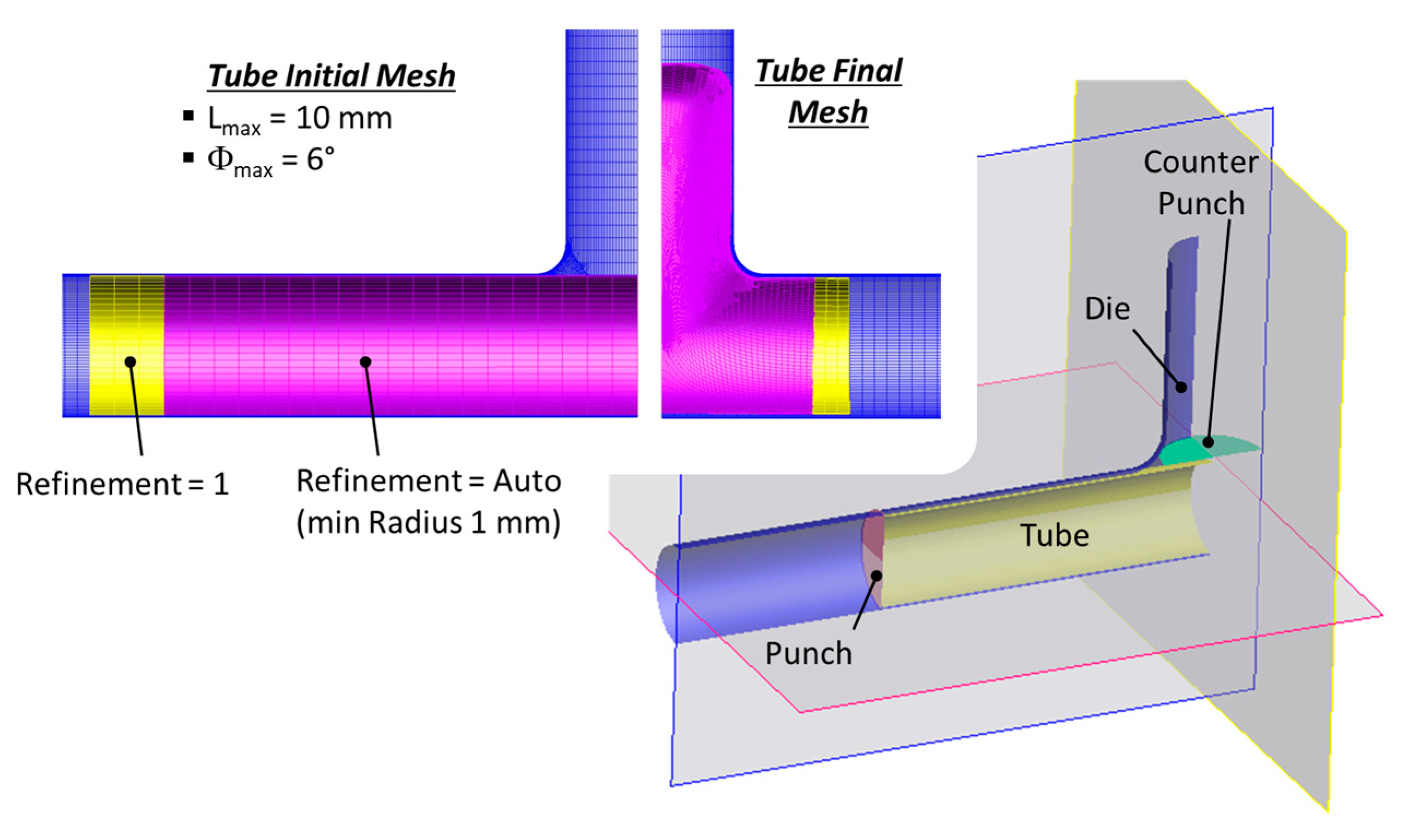

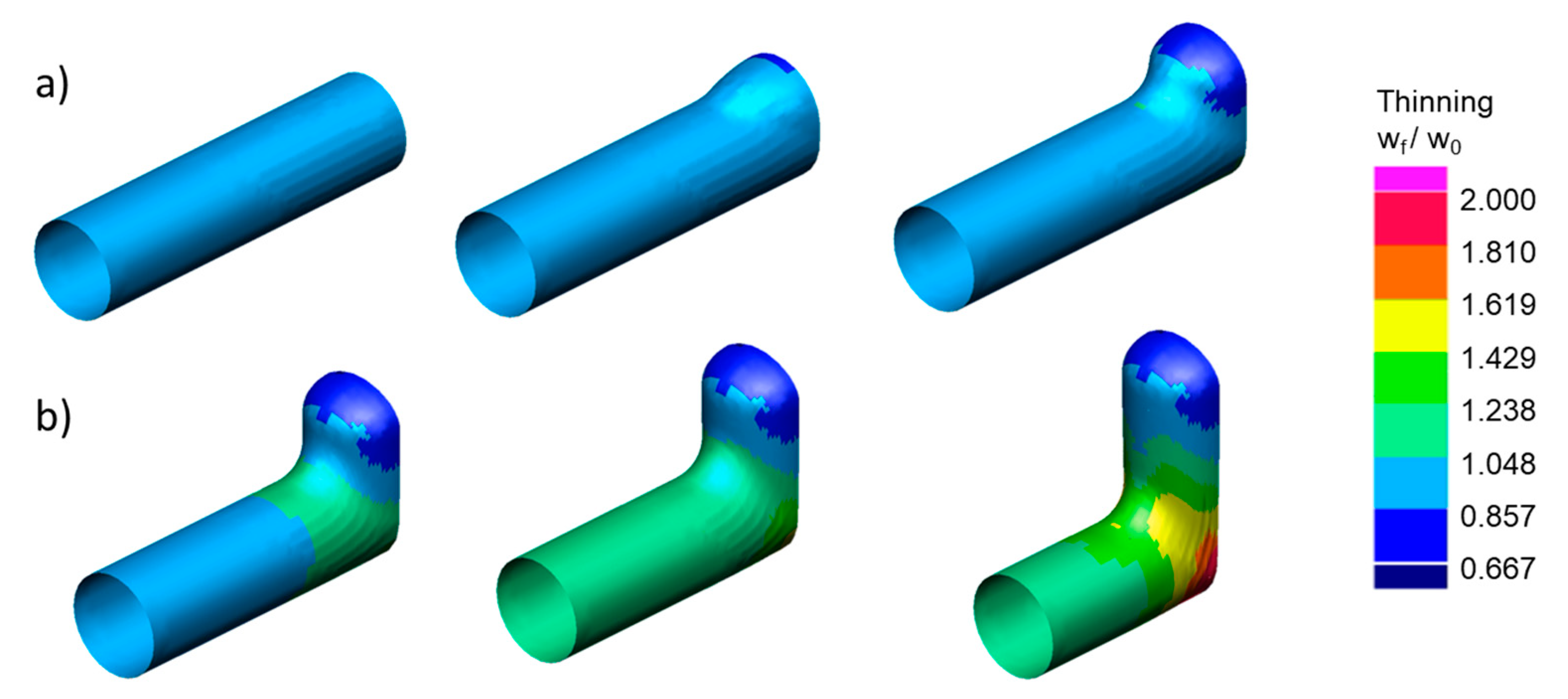
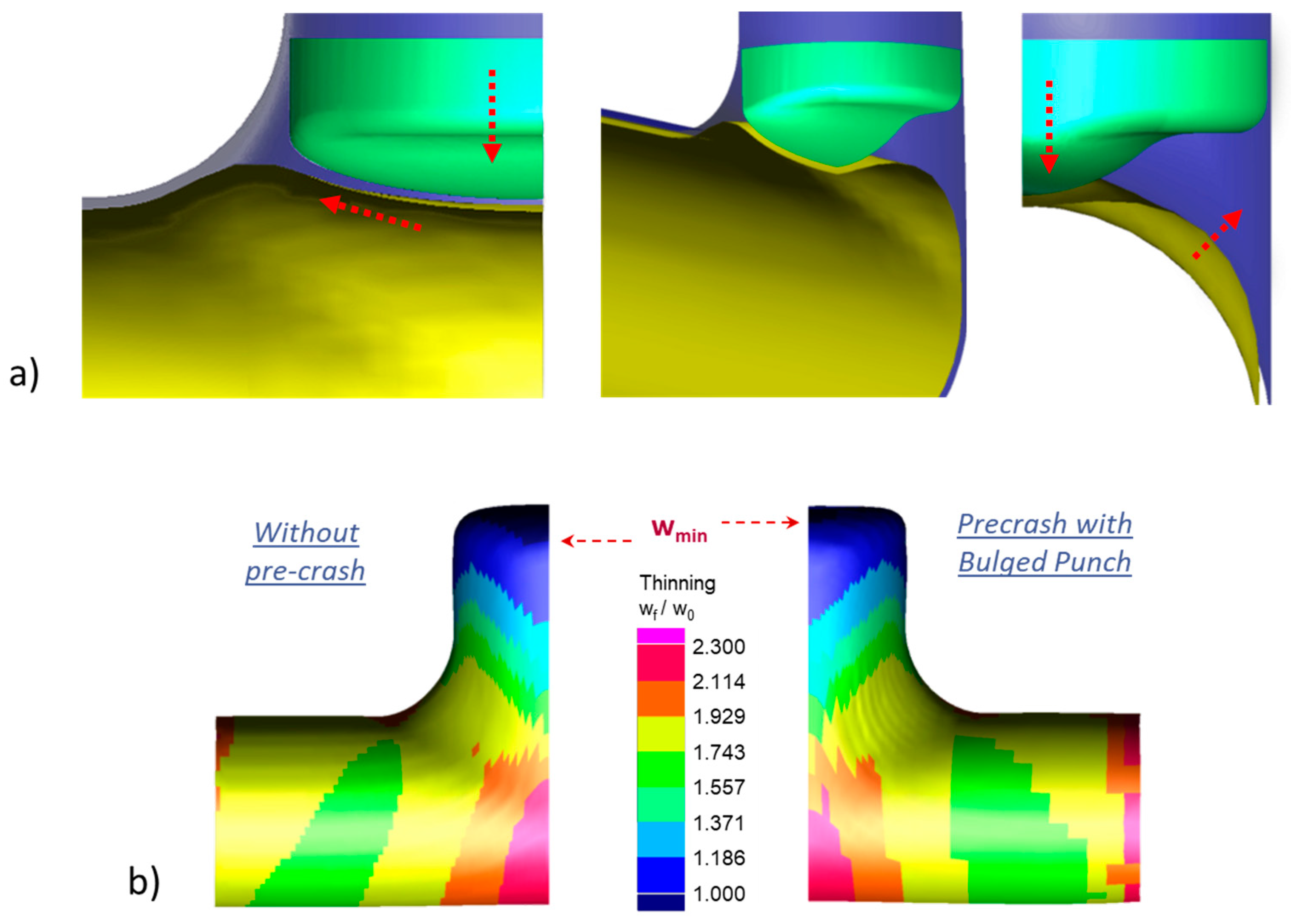



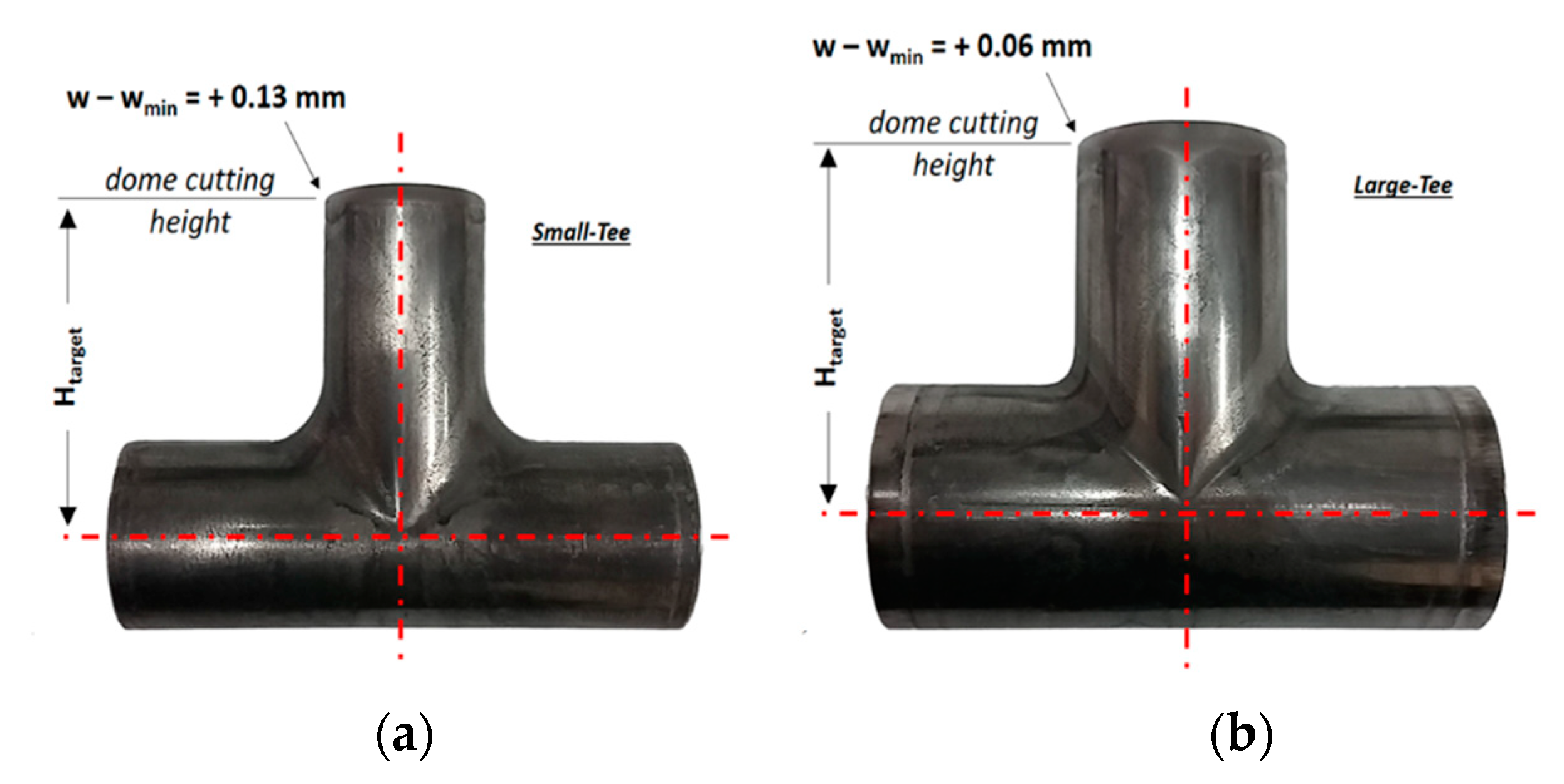
| Solver | PamStamp2G—Explicit |
| Meshing | Die/Punches: Rigid Shell Tube: Deformable Shell–Double symmetry planes |
| Material | AISI 316L—σ = 1453 × (ε + 0.159)0.634 |
| Friction | Coulomb—Tube–Die: 0.057 Coulomb—Tube–Punch: 0.12 |
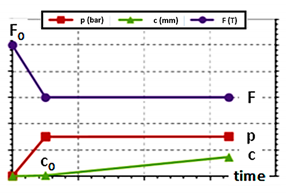 | Small-Tee | Large-Tee | |
| Process | |||
| Pressure (p) | p = 500 bar | p = 300 bar | |
| Punch velocity (v) | v0 = 1 mm/s v = 5 mm/s | v0 = 1 mm/s v = 5 mm/s | |
| Counter-punch (bulged) force (F) | F0 = 2.5 T 1 F = 1.5 T | F0 = 5 T 1 F = 3 T | |
| Domain for Tube optimization | |||
| Length (mm) | L ∈ (L1; L1 + 80) | L ∈ (L2; L2 + 100) | |
| Thickness (mm) | w ∈ (w1; w1 + 1.25) | w ∈ (w2; w2 + 2.00) | |
© 2020 by the authors. Licensee MDPI, Basel, Switzerland. This article is an open access article distributed under the terms and conditions of the Creative Commons Attribution (CC BY) license (http://creativecommons.org/licenses/by/4.0/).
Share and Cite
Fiorentino, A.; Ginestra, P.S.; Attanasio, A.; Ceretti, E. Numerical Optimization of the Blank Dimensions in Tube Hydroforming Using Line-Search and Bisection Methods. Materials 2020, 13, 945. https://doi.org/10.3390/ma13040945
Fiorentino A, Ginestra PS, Attanasio A, Ceretti E. Numerical Optimization of the Blank Dimensions in Tube Hydroforming Using Line-Search and Bisection Methods. Materials. 2020; 13(4):945. https://doi.org/10.3390/ma13040945
Chicago/Turabian StyleFiorentino, Antonio, Paola Serena Ginestra, Aldo Attanasio, and Elisabetta Ceretti. 2020. "Numerical Optimization of the Blank Dimensions in Tube Hydroforming Using Line-Search and Bisection Methods" Materials 13, no. 4: 945. https://doi.org/10.3390/ma13040945
APA StyleFiorentino, A., Ginestra, P. S., Attanasio, A., & Ceretti, E. (2020). Numerical Optimization of the Blank Dimensions in Tube Hydroforming Using Line-Search and Bisection Methods. Materials, 13(4), 945. https://doi.org/10.3390/ma13040945





